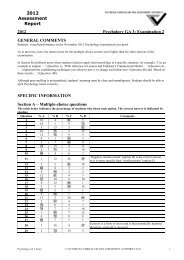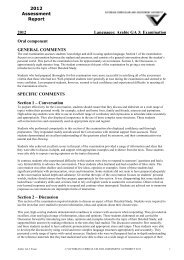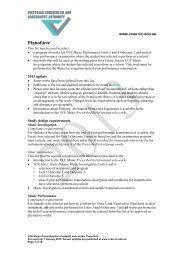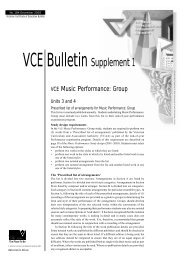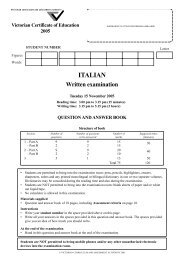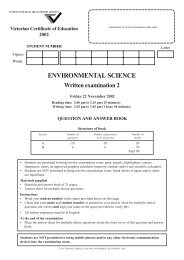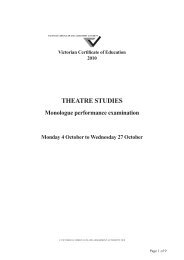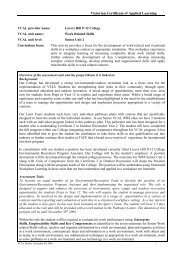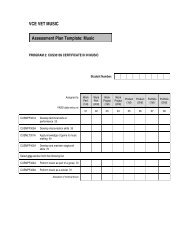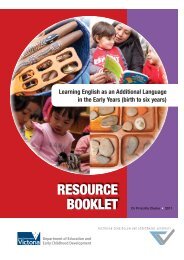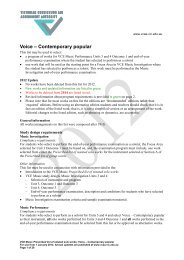television, digital media and children's learning - Victorian ...
television, digital media and children's learning - Victorian ...
television, digital media and children's learning - Victorian ...
You also want an ePaper? Increase the reach of your titles
YUMPU automatically turns print PDFs into web optimized ePapers that Google loves.
5. The government should appoint a Children’s Media Commissioner to develop a framework<br />
for all government activity associated with children’s education, health <strong>and</strong> welfare with<br />
<strong>media</strong> at their core.<br />
Updated regulations for the <strong>digital</strong> age<br />
DISCUSSION<br />
Commercial <strong>television</strong><br />
For thirty years, Australia has had a system requiring Children’s Television St<strong>and</strong>ards (CTS)<br />
which are currently under review. The overall goal of the CTS is ‘to promote Australia’s<br />
identity, character <strong>and</strong> cultural diversity’, by requiring programs specifically designed for<br />
Australian children <strong>and</strong> protecting them from ‘harmful effects’. In brief, the CTS require that<br />
commercial TV networks broadcast annually 260 hours of children’s programs (C) <strong>and</strong> 130<br />
hours of pre-school programs (P). Half of these must be first-release Australian content; all P<br />
programs must be Australian. Licensees must broadcast at least 96 hours of first-release<br />
Australian C drama over a three-year period, plus eight hours of repeat Australian drama.<br />
Given the enormous number of hours Australian children are watching (averaging over 5<br />
hours a day), not much of it is ACMA-approved C or P material. Even the programs classified<br />
as P or C leave much to be desired.<br />
ABC <strong>and</strong> SBS<br />
In October 2008 the Australian Government called for submissions to review the future roles<br />
of the Australian Broadcasting Corporation <strong>and</strong> the Special Broadcasting Service. (ABC <strong>and</strong><br />
SBS: Towards a <strong>digital</strong> future. Discussion paper, www.dbcde.gov.au/abcsbsreview)<br />
The government is seeking to clarify the vision <strong>and</strong> direction of the ABC <strong>and</strong> SBS as creative<br />
<strong>and</strong> responsible public broadcasters in the era of convergence <strong>and</strong> digitisation. This review<br />
will include an examination of <strong>children's</strong> programming <strong>and</strong> the discussion paper expects ‘the<br />
national broadcasters could play an enhanced role in <strong>children's</strong> programming’. At the<br />
Australia 2020 Summit the final report stated, ‘the ABC would have a specific education role in<br />
classrooms <strong>and</strong> across all industry sectors. This should be supplemented by the ABC having<br />
a separate <strong>children's</strong> channel.’<br />
Programming for children<br />
In October, 2008, Australian P classified programs broadcast on the commercial networks<br />
included:<br />
Commercial networks ABC<br />
• Puzzle Play (Ten)<br />
• Here's Humphrey (Nine)<br />
• Disney Playhouse (Seven)<br />
• Play School<br />
• Bananas in Pyjamas<br />
• In the Night Garden (UK)<br />
• Sesame Street (USA).<br />
Other programs classified <strong>and</strong> approved by ACMA as fulfilling their criteria for programming<br />
suitable for pre-schoolers, but not screened in October, include:<br />
• All for Children<br />
• For Children<br />
• How2 with the Hooley Dooleys<br />
• New McDonald's Farm<br />
• Raggs<br />
• Rock it<br />
• The Fairies<br />
• Hi 5<br />
• Arts Alive<br />
• Bambaloo<br />
13




